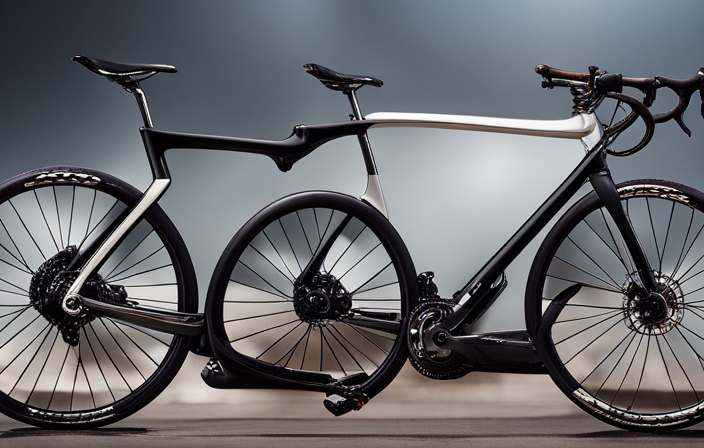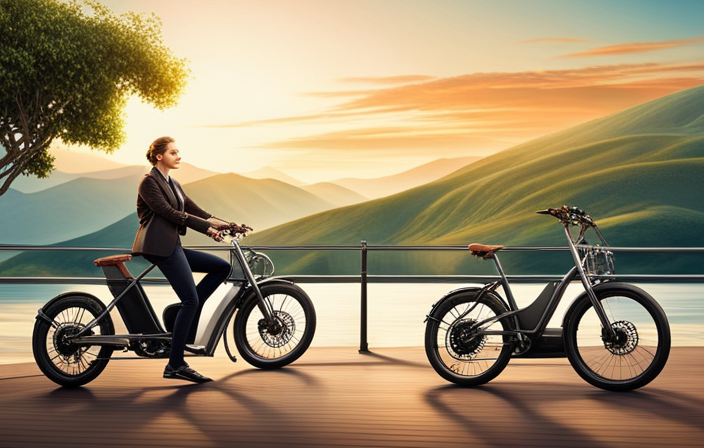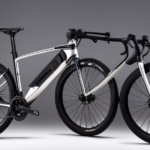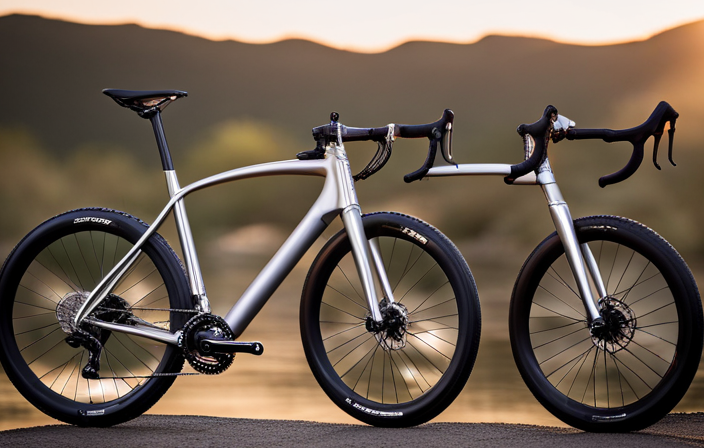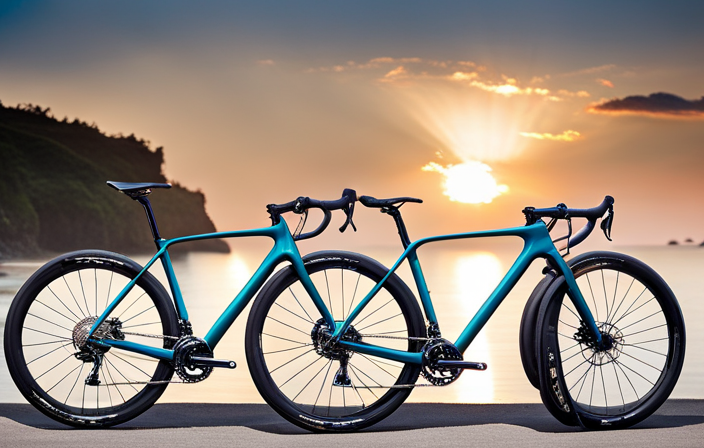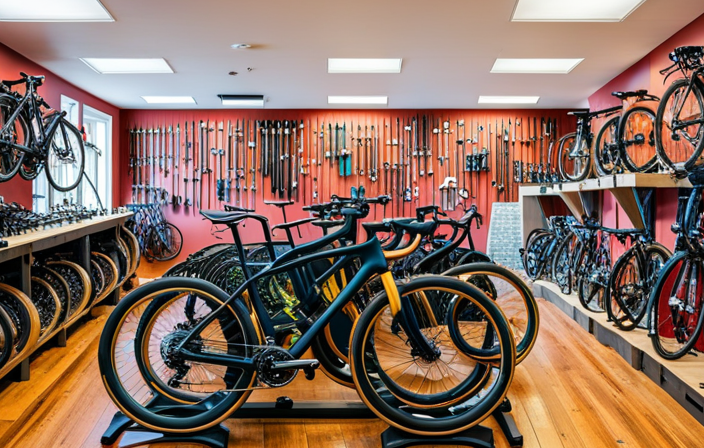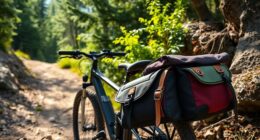If you’re gearing up to tackle gravel trails and venture beyond the usual routes, you might be curious about the expense required to acquire a gravel bike.
Well, hold onto your handlebars because I’ve got all the details for you.
From entry-level options that won’t break the bank to high-end bikes built for elite adventurers, we’ll dive into the factors that influence gravel bike prices and provide recommendations for every budget.
So, let’s saddle up and find out just how much a gravel bike will set you back!
Key Takeaways
- Brand reputation is a significant factor that influences gravel bike prices.
- Customizable options can increase the cost of a gravel bike.
- Advanced technology used in gravel bikes tends to drive up their prices.
- The materials used in the construction of a gravel bike can impact its cost.
Factors that Influence Gravel Bike Prices
One of the factors that influence gravel bike prices is the brand. Different brands have different reputations, and some are known for producing high-quality bikes that come with a higher price tag.
In addition to the brand, there are several other factors that affect gravel bike pricing. Custom gravel bike options can significantly impact the cost of a gravel bike. Some manufacturers offer customizable features such as frame material, drivetrain components, wheelsets, and brakes. These options allow riders to tailor their bikes to their specific needs and preferences but often come at an additional cost.
Another factor affecting gravel bike pricing is the level of technology and innovation incorporated into the design. Advanced features like suspension systems or electronic shifting can drive up the price considerably compared to more basic models.
The materials used in construction also play a role in determining the cost of a gravel bike. Bikes made from lightweight carbon fiber tend to be more expensive than those made from aluminum or steel due to the higher manufacturing costs associated with carbon fiber.
In conclusion, when it comes to determining the price of a gravel bike, factors such as brand reputation, custom options, technological advancements, and materials all come into play.
Now let’s explore entry-level gravel bikes as an alternative option without compromising quality or performance.
Entry-Level Gravel Bikes
Entry-level gravel bikes can be purchased at an affordable price, making them a great option for beginners or those on a budget. There are several affordable gravel bike brands that offer entry-level options with decent components and reliable performance. Here are five entry-level gravel bike options to consider:
-
Diamondback Haanjo 3: This versatile bike features a durable aluminum frame, disc brakes, and wide tires for off-road adventures.
-
Giant Revolt 2: With its lightweight ALUXX aluminum frame and wide-range gearing, this bike is perfect for tackling rough terrain.
-
Salsa Journeyman Claris 700: Designed for comfort and versatility, this bike offers smooth shifting and stable handling.
-
Specialized Diverge E5 Elite: Equipped with Shimano Tiagra components and hydraulic disc brakes, this bike delivers reliable performance on any surface.
-
Trek Checkpoint AL 3: This entry-level gravel bike combines durability with comfort, thanks to its lightweight aluminum frame and IsoSpeed decoupler.
These affordable options provide the opportunity to experience the thrill of riding gravel without breaking the bank. As you gain more experience and want to explore further possibilities, mid-range gravel bikes offer even more advanced features.
Mid-Range Gravel Bikes
If you’re looking to upgrade, mid-range gravel bikes offer a range of advanced features and performance options. These bikes are a step up from entry-level models and provide several benefits that make them worth considering.
One major advantage of mid-range options is the improved components they come with. They often have higher-quality drivetrains, which can result in smoother shifting and better overall performance. Additionally, mid-range gravel bikes tend to have more advanced suspension systems, allowing for greater control and comfort on rough terrain.
Comparing mid-range gravel bikes to high-end options, there are a few key differences to consider. While high-end bikes may offer even better components and more advanced technology, the improvements may not always justify the significant increase in price. Mid-range options often provide a great balance between performance and affordability.
Transitioning into the subsequent section about high-end gravel bikes, it’s important to note that while mid-range options offer many advantages, high-end models take things to another level in terms of both performance and price.
High-End Gravel Bikes
When it comes to high-end gravel bikes, you’ll find top-of-the-line components and cutting-edge technology. These bikes are designed for serious riders who want the best performance and durability on any terrain. High-end gravel bikes often feature lightweight carbon frames, which provide a smooth and responsive ride. They also come equipped with high-end drivetrains, such as Shimano Dura-Ace or SRAM Red, ensuring precise shifting and efficient power transfer.
In addition to their top-notch components, high-end gravel bikes offer advanced features that enhance the riding experience. Many of these bikes have wider tire clearance, allowing riders to tackle more challenging off-road trails with ease. Some models also come with integrated suspension systems or adjustable geometry options, providing added comfort and versatility.
High-end gravel bikes are often seen at gravel bike race events where riders compete against each other on various terrains. These races showcase the capabilities of these top-tier bikes and allow riders to push their limits in a competitive setting.
Transitioning into the next section about custom-built gravel bikes, it’s worth noting that some cyclists prefer to take the customization route when it comes to their gravel bike setup.
Custom-Built Gravel Bikes
When it comes to gravel bikes, custom-built options offer a range of benefits.
The ability to customize every aspect allows for a bike that is perfectly tailored to your specific needs and preferences.
From frame material to components, the possibilities are endless.
However, it’s important to note that the average cost range for custom builds can vary significantly depending on the level of customization and the quality of components chosen.
So, while customization offers many advantages, it’s also important to consider budget constraints when embarking on a custom gravel bike build.
Benefits of Customization
Customization offers numerous benefits when it comes to gravel bikes. It allows riders to tailor their bike to their specific needs and preferences. Here are some of the advantages of customization options and personalized fit:
-
Optimal Comfort: Customizing your gravel bike ensures that it fits you perfectly, resulting in a comfortable riding experience.
-
Enhanced Performance: By customizing components such as handlebars, saddles, and drivetrains, you can optimize your bike for better performance on different terrains.
-
Improved Handling: Tailoring the frame geometry and wheel size allows for precise handling that suits your riding style.
-
Unique Aesthetics: With customization, you can choose colors, graphics, and accessories that reflect your personal style and make your bike stand out.
-
Long-Term Investment: Custom-built bikes are built with high-quality components that can be upgraded or replaced over time, making them a long-lasting investment.
Now let’s dive into the average cost range for custom builds.
Average Cost Range for Custom Builds
To get a custom-built gravel bike that suits your needs, you can expect to pay within a certain price range. Custom builds offer several advantages, such as the ability to choose specific components and tailor the bike to your preferences. While it may seem like a costly option initially, there are cost-saving alternatives available for those on a tighter budget. By opting for more affordable parts or selecting used components in good condition, you can significantly reduce the overall cost of your custom build. However, keep in mind that compromising on quality may affect the performance and durability of the bike. In order to emphasize the potential savings with customization, consider the following table:
| Component | Average Cost |
|---|---|
| Frame | $500 – $2000 |
| Groupset | $400 – $1500 |
| Wheels | $300 – $1000 |
| Finishing Kit | $200 – $800 |
Considering these average costs and exploring cost-saving options can help you create a customized gravel bike without breaking the bank.
Moving onto used gravel bikes…
Used Gravel Bikes
If you’re looking for a used gravel bike, you can find one at various price points. Buying used can be a great way to save money while still getting a high-quality bike. Here are some key points to consider when it comes to used gravel bike prices:
-
Bargain finds: There are often great deals available on the used market, with prices ranging from $500 to $1500 depending on the age, condition, and brand of the bike.
-
Higher-end options: If you’re willing to spend a bit more, you can find top-of-the-line used gravel bikes for around $2000 to $3000. These bikes may have premium components and features that would be much pricier if bought new.
-
Be cautious: While buying used can save you money, there are some potential downsides to consider. Used bikes may have hidden issues or wear and tear that could require costly repairs down the line.
When considering buying a used gravel bike, it’s important to weigh the pros and cons of saving money versus potentially dealing with additional costs in the future. Speaking of additional costs… [transition into next subtopic].
Additional Costs to Consider
One important factor to consider when purchasing a used gravel bike is the potential for unexpected expenses. While buying a used bike can save you money upfront, it’s crucial to account for additional costs that may arise. These can include maintenance expenses, such as replacing worn-out components or repairing any damage that might not be immediately apparent.
To give you an idea of these potential costs, here is a table showing some common items and their average prices:
| Item | Average Price |
|---|---|
| New Tires | $40-$80 |
| Brake Pads | $10-$30 |
| Chain | $15-$50 |
| Pedals | $30-$150 |
As you can see, these expenses can add up quickly. It’s essential to budget for these additional costs when purchasing a used gravel bike to avoid any financial surprises down the road.
Now that we’ve discussed the additional costs involved in owning a gravel bike, let’s explore financing options available for those looking to purchase one without breaking the bank.
Financing Options for Gravel Bikes
There are various financing options available for those looking to purchase a used gravel bike without incurring excessive upfront expenses. Bike financing options can provide a convenient way to spread out the cost of a gravel bike over time, making it more affordable for individuals on a budget.
One popular financing option is through bike shops themselves, which often offer installment plans or store credit that can be used towards the purchase of a gravel bike. Another option is to apply for a personal loan from a bank or credit union, which can provide flexibility in terms of repayment duration and interest rates.
The benefits of financing a gravel bike are numerous. Firstly, it allows individuals to get their hands on a high-quality bike without having to pay the full amount upfront. This can be especially helpful for those who may not have enough savings readily available but still want to enjoy the thrill and adventure that comes with riding a gravel bike.
Additionally, financing enables customers to choose from a wider range of bikes within their budget, as they have the freedom to select more expensive models and pay them off gradually.
In conclusion, there are several bike financing options available for those interested in purchasing a used gravel bike. Whether through installment plans at local shops or personal loans from financial institutions, these options make it easier for individuals to afford their dream gravel bike without breaking the bank all at once.
Now let’s explore some tips for finding the best deals on used gravel bikes…
Tips for Finding the Best Deals
When searching for the best deals on used gravel bikes, it’s important to consider factors such as condition, brand reputation, and seller credibility. Finding discounted prices requires some effort and research, but it can lead to significant savings.
Here are some tips for finding the best deals:
-
Check online marketplaces: Websites like Craigslist, eBay, and Facebook Marketplace often have listings for used gravel bikes at lower prices than retail.
-
Explore local bike shops: Some bike shops may offer discounts on previous year models or have sales events where you can find great deals.
-
Attend bike swap meets or garage sales: These events are a treasure trove of used bikes at discounted prices.
-
Join online cycling communities: Participating in cycling forums or social media groups can help you connect with other cyclists who may be selling their gravel bikes at a reduced price.
-
Negotiate with sellers: Don’t be afraid to haggle and negotiate the price with sellers. They may be willing to lower the price if they’re motivated to sell.
By following these tips and being proactive in your search for the best deals, you’ll increase your chances of finding an affordable used gravel bike.
Transitioning into the subsequent section about ‘renting vs. buying a gravel bike’, remember that exploring all options is crucial when making a decision about acquiring a new ride.
Renting vs. Buying a Gravel Bike
Deciding whether to rent or buy a gravel bike can be a tough choice, but weighing the pros and cons is essential.
Renting a gravel bike has its benefits. Firstly, it allows you to try out different models before committing to a purchase. This way, you can determine which features suit your riding style and preferences without spending a fortune. Additionally, renting is a great option if you only plan on using the bike occasionally or for a specific event. It saves you the hassle of storage and maintenance when not in use.
However, buying a gravel bike also comes with its advantages. The biggest benefit is ownership. When you buy your own bike, it becomes an investment that you can use whenever and wherever you want. You have the freedom to explore new terrains and go on adventures at any time. Moreover, owning a gravel bike allows for customization options according to your specific needs and desires.
Transitioning into the subsequent section about ‘gravel bike demos and test rides,’ it’s important to note that these options are available both for rentals and purchases. Taking advantage of demos and test rides can help narrow down your choices further by providing hands-on experience before making any decisions on whether renting or buying is right for you.
Gravel Bike Demos and Test Rides
If you’re unsure about whether to rent or buy a gravel bike, taking advantage of gravel bike demos and test rides can give you firsthand experience to help inform your decision.
There are several benefits to participating in a gravel bike demo or test ride. Firstly, it allows you to try out different models and brands of gravel bikes, so you can get a sense of which one feels the most comfortable and suits your riding style. You can also assess the bike’s handling, responsiveness, and overall performance on various terrains.
Additionally, demos and test rides provide an opportunity to ask questions and get expert advice from knowledgeable staff members who can guide you through the features and specifications of each bike.
One advantage of test rides is that they allow you to evaluate how well a particular gravel bike meets your specific needs and preferences. For example, if you plan on using the bike for long-distance endurance rides, you can see if it provides enough comfort for extended periods in the saddle. On the other hand, if speed is your priority, you can test its acceleration capabilities and maneuverability.
By participating in gravel bike demos and test rides, you gain valuable insights into different models without committing financially upfront. This experience will better equip you when making recommendations for different budgets…
Recommendations for Different Budgets
For those on a tight budget, there are affordable options available for purchasing a gravel bike. You don’t have to break the bank to get started on your gravel adventures.
Here are some recommendations for different budgets:
-
Entry-Level Budget: If you’re just getting into gravel riding and want a reliable bike without spending too much, consider looking at brands like Giant or Diamondback. They offer entry-level gravel bikes that provide good value for the price.
-
Mid-Range Budget: If you have a bit more money to spend, brands like Salsa and Specialized offer great options in the mid-range price range. These bikes often come with better components and more advanced features, giving you an enhanced riding experience.
-
High-End Budget: For those who are willing to invest in top-of-the-line equipment, brands like Trek and Santa Cruz have high-end gravel bikes that deliver exceptional performance. These bikes are built using premium materials and cutting-edge technology, ensuring optimal performance on any terrain.
When it comes to financing options for gravel bikes, many bike shops offer payment plans or financing options that can make buying a bike more manageable. Additionally, if you’re unsure about committing to purchasing a gravel bike right away, renting one can be a cost-effective alternative. Renting allows you to try out different models before making a final decision.
In the subsequent section about maintenance and upgrades, we’ll explore how to keep your new gravel bike in top shape while discussing potential ways to enhance its performance even further.
Maintenance and Upgrades
To keep your new gravel bike in top shape and enhance its performance even further, it’s important to prioritize maintenance and consider potential upgrades.
Regular maintenance is key to prolonging the lifespan of your bike and ensuring a smooth ride. Here are some essential tips for maintenance:
-
Cleanliness: After each ride, make sure to clean your gravel bike thoroughly, including the drivetrain, brakes, and frame. This will prevent dirt and grime from causing damage or affecting performance.
-
Lubrication: Regularly lubricate the chain and other moving parts to reduce friction and ensure smooth shifting.
-
Tire Pressure: Check tire pressure before every ride to optimize traction and minimize the risk of flats.
-
Brake Pad Replacement: Keep an eye on your brake pads’ wear indicators and replace them when necessary for optimal braking power.
When it comes to upgrades, there are several options that can enhance your gravel biking experience. Some popular choices include upgrading the tires for better grip on different terrains or investing in a more comfortable saddle for long rides.
Incorporating these tips for maintenance and considering essential upgrades will help you get the most out of your gravel bike.
As we transition into discussing gravel bike communities and resources, it’s worth noting that these platforms can provide additional insights on maintenance techniques and upgrade recommendations without requiring any specific steps be taken.
Gravel Bike Communities and Resources
Joining gravel bike communities and utilizing online resources can provide valuable insights and support for your gravel biking journey.
Being a part of these communities allows you to connect with fellow gravel bikers who share the same passion and can offer advice on routes, gear, and training. These communities often organize gravel bike events that are a great way to challenge yourself, meet new people, and explore different terrains.
In addition to the community aspect, online resources such as forums, blogs, and websites dedicated to gravel biking are abundant. These platforms provide a wealth of information on topics like maintenance tips, recommended accessories, and reviews of various gravel bike models. They can help you stay up-to-date with the latest trends in the gravel biking world and make informed decisions when it comes to upgrading or purchasing new gear.
When it comes to accessories specifically, there are numerous options available for enhancing your gravel biking experience. From saddlebags for carrying essentials during long rides to specialized tires designed for rugged terrain, these accessories can greatly improve your comfort and performance while out on the trails.
In conclusion, investing in your gravel biking journey by joining communities and utilizing online resources is essential for gaining knowledge about upcoming events and finding the right accessories. This will ultimately enhance your overall experience as a gravel biker.
Conclusion: Investing in Your Gravel Biking Journey
Investing in your gravel biking journey by becoming a part of the community and utilizing online resources is essential for gaining knowledge and enhancing your overall experience. When it comes to gravel biking, there are various aspects to consider, such as custom bike options and the pros and cons of second-hand bikes.
Custom bike options allow you to tailor your gravel bike specifically to your preferences and needs. This can include selecting the frame material, components, and even the color scheme. While custom bikes can be more expensive than off-the-shelf options, they offer a personalized riding experience that is worth the investment.
On the other hand, second-hand bikes provide a more affordable option for those on a budget. However, it’s important to carefully evaluate the condition of the bike before making a purchase. Look for any signs of wear or damage that may affect its performance. Additionally, consider factors such as warranty coverage and compatibility with newer components.
Both custom bikes and second-hand bikes have their own advantages and disadvantages. Ultimately, it boils down to personal preference, budget constraints, and individual circumstances.
By being an active member of gravel biking communities online, you can tap into a wealth of knowledge shared by experienced riders. From tips on maintenance to recommendations on trails and events, these resources can greatly enhance your gravel biking journey.
In conclusion, investing in your gravel biking journey through community engagement and utilizing online resources will help you make informed decisions about custom bike options or purchasing second-hand bikes. Remember to weigh the pros and cons based on your needs before making any final decisions. Happy riding!
Frequently Asked Questions
Are gravel bikes suitable for beginners or should I start with a different type of bike?
For beginners, gravel bikes can be a great option compared to road bikes. Gravel bikes offer more versatility and stability, making them easier to handle on different terrains. They have wider tires for better traction and stronger frames for durability.
While they may not have suspension like mountain bikes, it isn’t necessary for beginners as gravel roads are generally less rough. Overall, gravel bikes provide a comfortable ride with the ability to explore various surfaces.
What are the most important maintenance tasks for keeping a gravel bike in good condition?
To ensure your gravel bike remains in top shape, there are a few essential maintenance tasks you should prioritize.
Regularly cleaning and lubricating the drivetrain will keep it running smoothly and prevent premature wear.
Checking tire pressure and replacing worn-out tires is crucial for optimal performance on varied terrain.
Additionally, inspecting the brakes, tightening bolts, and keeping the frame clean will contribute to a safe and enjoyable riding experience.
By performing these cost-effective maintenance tasks, you’ll maximize the longevity of your gravel bike.
Can I use a gravel bike for other types of cycling, such as road biking or mountain biking?
Gravel bikes are versatile and can handle long distance touring. They are designed to tackle various terrains, making them suitable for road biking or mountain biking as well.
With their durable frames, wider tires, and comfortable riding position, gravel bikes provide stability and control on different surfaces. Moreover, they can be used for commuting in urban areas due to their ability to handle both pavement and rougher paths.
Are there any specific accessories or gear that I should consider purchasing along with a gravel bike?
Oh man, when it comes to gravel biking, there are some killer accessories and gear you gotta get your hands on.
First off, specific accessories for gravel biking include things like a sturdy bike rack for those epic adventures, a reliable GPS device to keep you on track, and some gnarly mudguards to keep the dirt from taking over.
And don’t forget about essential gear like a helmet that can handle rough terrain and a hydration pack to keep you fueled up.
Trust me, these items are worth every penny!
How often should I expect to replace components or upgrade parts on a gravel bike?
When it comes to the component replacement schedule and cost of upgrading parts on a gravel bike, it varies depending on several factors.
Generally, you can expect to replace components such as brake pads, tires, and chains more frequently due to the rugged nature of off-road riding.
Upgrading parts like wheels or drivetrain can be done based on personal preferences or performance goals.
The cost of these replacements and upgrades can range from affordable options to higher-end components for enhanced performance.
Conclusion
In conclusion, investing in your gravel biking journey is a decision that can bring both joy and excitement.
Whether you choose an entry-level bike or splurge on a high-end model, the experience of riding through rugged terrains and exploring new paths will be unmatched.
The sense of freedom as you pedal along the gravel roads, feeling the wind against your face, is truly exhilarating. And with maintenance and upgrades, you can continuously improve your bike’s performance to suit your evolving needs.
Joining gravel bike communities and utilizing available resources will also enhance your knowledge and passion for this sport.
So why wait? Embrace the thrill of gravel biking today!
